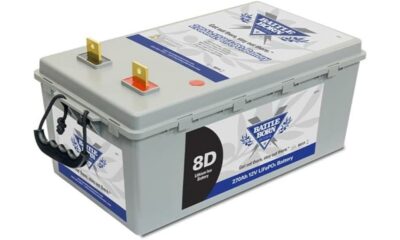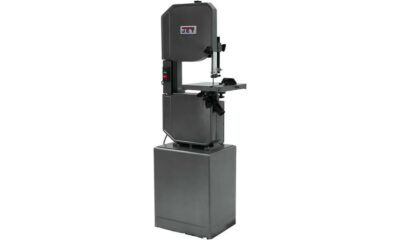Home Decor
What to Do With an Old Dresser
Learn how to rescue your old dresser from the landfill and transform it into a functional piece of art that's both stylish and sustainable.
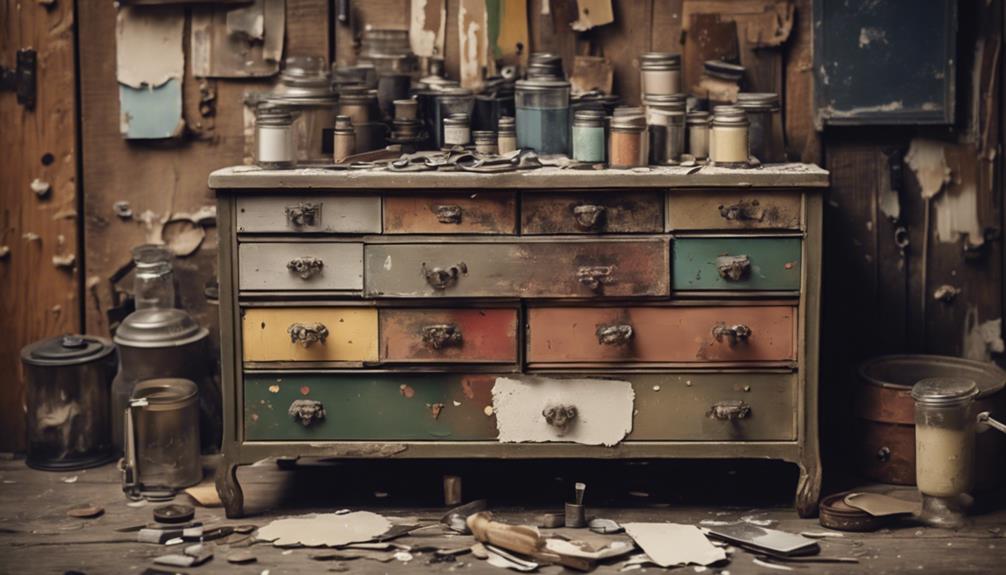
You've got an old dresser that's seen better days, but instead of sending it to the landfill, you can breathe new life into it with a little creativity and some TLC. You can repurpose the drawers as a bookcase, jewelry holder, or nightstand, or add a fresh coat of paint for a new look. Alternatively, you can upcycle the entire dresser into stylish furniture like a bench, shelves, or storage units. With some imagination, you can transform it into a kitchen island, pet station, or home office desk. There's a world of possibilities waiting to be explored…
Key Takeaways
• Transform an old dresser into a functional piece, like a bookcase, jewelry holder, or nightstand, with a fresh coat of paint.
• Repurpose dresser drawers as unique storage solutions, such as a Kids Storage Bench, wall unit, or under-bed storage.
• Upcycle an old dresser into stylish and functional furniture, like a bench, shelf, or storage unit, to provide creative storage solutions.
• Give an old dresser a makeover with paint and refinishing options, like chalk paint, distressed finishes, or high-gloss paint, to update its look.
• Repurpose an old dresser for outdoor use, transforming it into a planter stand, potting bench, or functional outdoor furniture to enhance outdoor living areas.
Transforming Dresser Drawers
Transforming your old dresser drawers into functional pieces can breathe new life into discarded furniture and add a touch of creativity to your home decor. By repurposing these old furniture pieces, you can create unique and functional items that not only reduce waste but also showcase your creativity.
One of the most popular repurposed dresser ideas is to turn them into a bookcase. Simply separate and attach the front pieces vertically to create shelves, and you'll have a one-of-a-kind storage unit.
Alternatively, you can hang a drawer on the wall and add hooks to create a jewelry holder or mount the fronts on brackets to create a wall unit for kids' books. You can even transform a dresser drawer into a nightstand by splitting it, disassembling the drawers, and giving it a fresh coat of paint.
With a little creativity, you can breathe new life into old furniture and create functional pieces that reflect your personal style.
Creative Storage Solutions
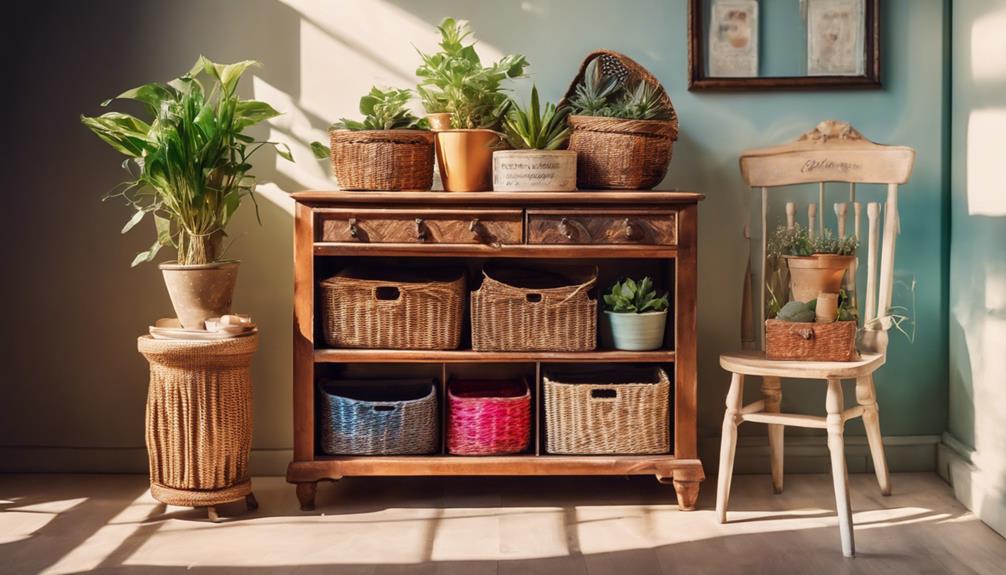
By thinking outside the box, you can repurpose old dresser drawers to create unique storage solutions that cater to your specific needs, from jewelry and book storage to clever hiding spots for kids' items.
With a little creativity, you can breathe new life into old furniture. Use those drawers to create a Kids Storage Bench, where toys and supplies are kept organized and within reach.
Consider repurposing the drawers as wall units, ottomans, or under-bed storage for practical organization. You can even turn them into functional pieces like command zones, dog beds, or dollhouses for creative storage options.
Get inspired by exploring DIY projects that transform dresser drawers into garden displays, cat condos, or headboards. By repurposing old dressers, you can find versatile storage solutions for unconventional spaces like the garage, shed, or outdoors.
With a little imagination, you can give old furniture a new purpose, making the most of your old dresser's potential.
Upcycled Furniture Projects

You can repurpose an old dresser into a stylish and functional piece of furniture, such as a bench, shelf, or storage unit, that adds a personal touch to your home decor.
Through upcycled furniture projects, you can transform an old dresser into a unique piece that not only reduces waste but also provides creative storage solutions for various spaces in your home.
Whether you're looking to create a one-of-a-kind bench or a functional storage unit, upcycling old furniture can be a fun and rewarding DIY project.
By repurposing an old dresser, you can give new life to a piece of furniture that would otherwise end up in a landfill.
Upcycled dresser projects can range from simple DIY makeovers to more complex furniture conversions, allowing you to get creative and experiment with different styles and designs.
With a little imagination and some basic DIY skills, you can turn an old dresser into a functional piece of furniture that reflects your personal style and adds character to your home.
Dresser Makeover Ideas

As you consider giving your old dresser a makeover, you're likely wondering where to start.
Two essential steps in the process are exploring paint and refinish options, which can completely transform the look and feel of your dresser, and updating hardware accents to add a touch of modernity.
Paint and Refinish Options
With a fresh coat of paint or a new finish, an old dresser can be transformed into a one-of-a-kind piece that reflects your personal style.
You can give your old furniture a Repurposed Life by exploring various paint and refinish options. Consider painting your dresser with chalk paint for a trendy, matte finish that requires minimal prep work.
Alternatively, refinish it with a distressed look by sanding edges and corners after painting for a rustic, weathered appearance. If you want a modern look, use a high-gloss paint to give your dresser a sleek finish that reflects light and adds a pop of color to a room.
For a classic, elegant look, stain your dresser to highlight the natural wood grain, which complements traditional decor. You can also experiment with different painting techniques like ombre, stenciling, or color blocking to transform your old dresser into a unique and stylish piece of furniture.
Update Hardware Accents
Swap out outdated hardware accents on your old dresser for a quick, budget-friendly facelift that can completely revamp its look and feel. By updating the hardware accents, you can give your dresser a fresh, modern look that complements your existing decor. This simple DIY project requires minimal effort and investment, making it an ideal solution for those on a budget.
When selecting new hardware accents, take into account the overall style and color scheme of your dresser. Choose hardware that complements these elements to create a cohesive and polished look.
Here are some popular hardware accent options to explore:
| Hardware Accent Style | Description |
|---|---|
| Modern Knobs | Sleek, minimalist designs in a variety of finishes |
| Vintage-Style Handles | Ornate, decorative designs with an antique flair |
| Industrial-Chic Pulls | Edgy, industrial-inspired designs with an urban vibe |
| Crystal Knobs | Luxurious, crystal-encrusted knobs for a touch of elegance |
Repurposing for Outdoor Use
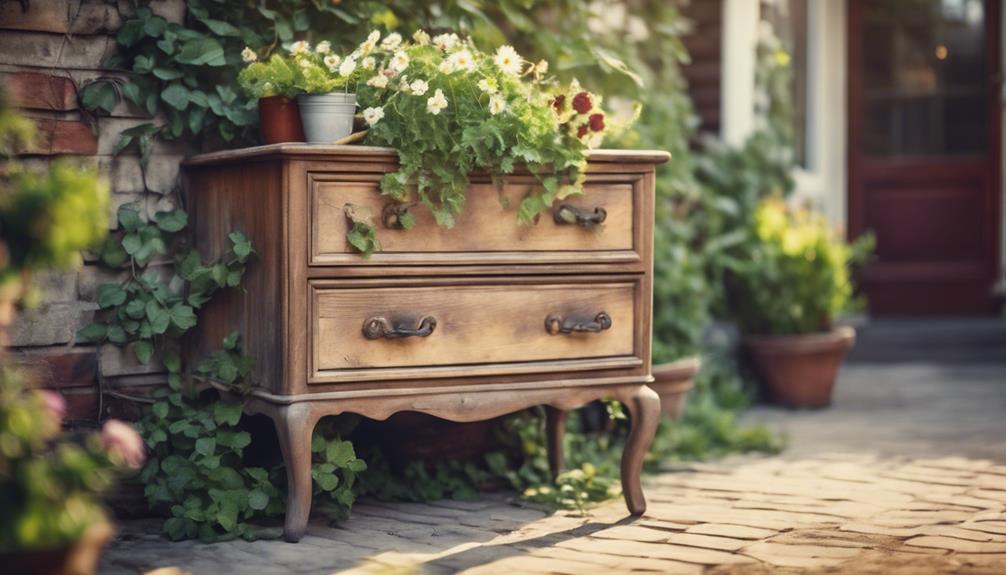
Transform your old dresser into a charming outdoor focal point by repurposing it as a unique planter stand, potting bench, or quirky outdoor bar. You can breathe new life into your old furniture by incorporating it into your garden decor.
Consider removing the drawers and adding shelves to create a functional potting bench, perfect for storing gardening supplies and tools. Alternatively, you can paint the dresser with outdoor-friendly paint and use it as a storage solution for outdoor items.
You can even repurpose the dresser as a decorative piece on your porch or patio, adding a touch of charm and functionality to your outdoor space. By repurposing your old dresser for outdoor use, you'll not only reduce waste but also add character and functionality to your garden or outdoor living area.
DIY Home Decor Inspiration
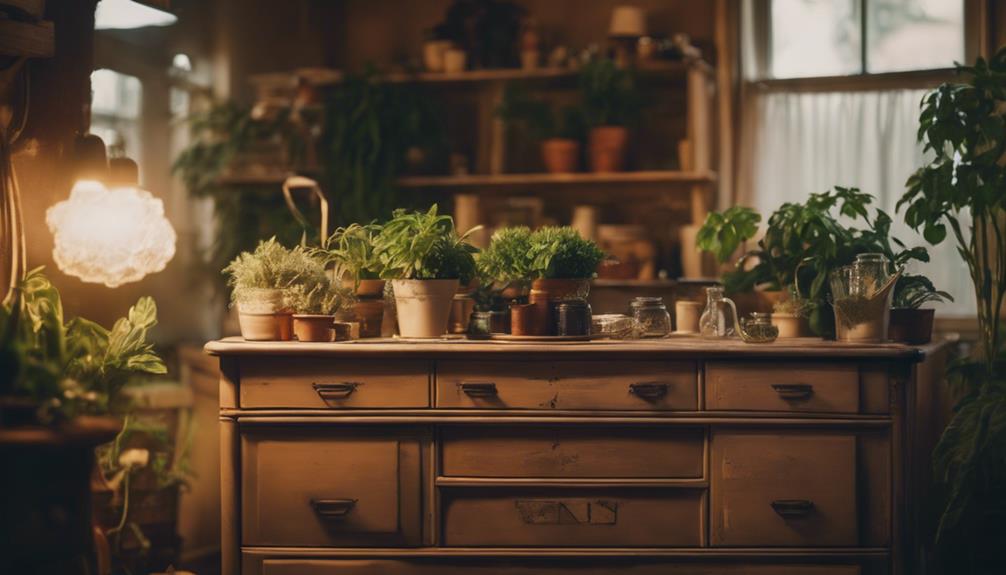
You can discover a world of creative possibilities by repurposing old dresser drawers into unique, functional pieces that add character to your home decor. With a little imagination, you can transform an old chest of drawers into a one-of-a-kind conversation starter.
Visit your local thrift store to find the perfect piece to repurpose, or breathe new life into a family heirloom.
Here are a few diy home decor inspiration ideas to get you started:
- Repurpose dresser drawers into a functional bookcase by separating and attaching front pieces vertically for shelves.
- Transform a dresser drawer into a unique jewelry holder by hanging it on the wall and adding hooks.
- Create a stylish and practical storage ladder by repurposing old drawers and attaching them securely to a small stepladder.
Giving Old Dressers New Life
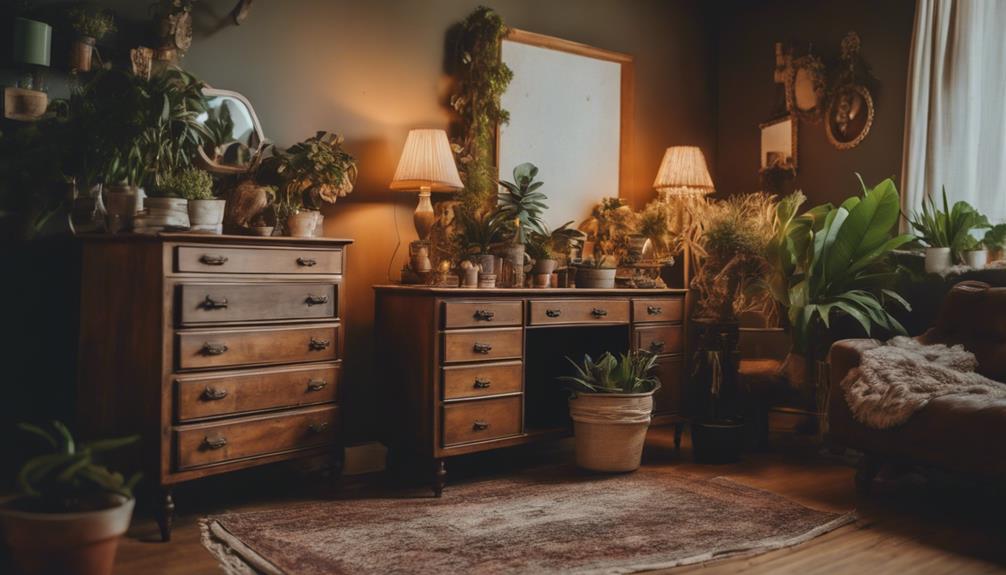
By repurposing an old dresser, you can breathe new life into a discarded piece of furniture and create a one-of-a-kind addition to your home decor. Transforming furniture through upcycling can give your old dresser a new purpose, and you can get creative with the possibilities.
You can turn it into a functional piece like a bench, shelf, or storage unit, or get more innovative and create a dollhouse, pet feeding station, or even a hidden laptop workspace. The beauty of repurposing an old dresser lies in its cost-effectiveness and the opportunity to personalize your furniture while promoting sustainability.
By taking on this DIY project, you'll not only reduce waste but also add a unique touch to your home. With a little creativity, you can turn an old dresser into a conversation starter and a demonstration of your resourcefulness.
Frequently Asked Questions
How Can I Repurpose an Old Dresser?
You're wondering how to repurpose an old dresser, and the possibilities are endless!
You can transform it into a stylish storage bench, a functional shelf for displaying decorative items, or even a unique piece of furniture like a dollhouse or pet feeding station.
Get creative with the drawers too – turn them into ottomans, jewelry holders, or wall units for extra storage.
With a little DIY magic, that old dresser can become a stunning addition to your home.
How Do You Redo an Old Wooden Dresser?
You're ready to breathe new life into that old wooden dresser. To redo it, start by sanding away the old finish and imperfections.
Next, apply a primer to prepare the surface for painting or staining.
Then, use high-quality paint or stain to give it a fresh look. Consider adding new hardware or decorative elements for a modern touch.
Can You Turn a Dresser Into a Bookshelf?
You're wondering if you can turn a dresser into a bookshelf. The answer is yes, you can!
By removing the drawers, sanding and painting the dresser, and securing the drawers in place, you can create a unique and functional bookshelf.
This repurposed piece won't only add character to your room but also provide ample storage for your books.
Can You Paint Over an Old Dresser?
As you stand before that outdated dresser, wondering what to do with it, remember that a fresh coat of paint can work wonders!
You can, in fact, paint over an old dresser to give it a brand-new look. By sanding and priming the surface, you'll guarantee a smooth finish.
Choose a high-quality paint, and consider trendy chalk paint or quick-drying spray paint for a professional-looking result.
Conclusion
As you've seen, an old dresser is like a time capsule, waiting to be rediscovered and revamped.
From transforming drawers into clever storage solutions to upcycling them into outdoor planters, the possibilities are endless.
So, don't be a Philistine and toss that vintage dresser; instead, give it a fresh coat of paint and a new lease on life.
Who knows, it might just become the crown jewel of your DIY home decor.
Vivienne – Your Content Companion Vivienne is your content companion, curating valuable tips, advice, and inspiration to guide you on your home decor journey. From insightful blog posts to informative product descriptions, she’s here to empower you with the knowledge you need to create your dream space.
Home Decor
What Are Modern Urban Indonesian Home Decor Styles?
Get inspired by the vibrant fusion of traditional Indonesian aesthetics and contemporary design that transforms urban homes into unique sanctuaries. Discover more!

Modern urban Indonesian home decor styles mix vibrant cultural elements with contemporary aesthetics. You'll notice natural materials like wood, bamboo, and rattan promoting sustainability and warmth. Open floor plans enhance airflow and light, while colorful patterns and textures draw from traditional motifs, including batik. Eco-friendly and minimalist furniture solutions maximize utility in smaller spaces. You can bring the outdoors in with large windows and tropical landscaping, creating a seamless connection with nature. Handcrafted accessories and unique art pieces add character. And if you keep exploring, you'll uncover even more ways to infuse your space with Indonesian flair.
Key Takeaways
- Modern urban Indonesian home decor emphasizes natural materials like wood, bamboo, and rattan for sustainability and warmth.
- Open floor plans enhance airflow and light, creating a harmonious living space.
- Vibrant colors and intricate patterns, inspired by traditional motifs, add cultural depth to the decor.
- Eco-friendly and multi-functional furniture maximizes utility while reflecting personal style and cultural richness.
- Indoor-outdoor connections through large windows and landscaped gardens promote relaxation and a seamless living experience.
Design Elements of Modern Decor

Modern urban Indonesian home decor frequently incorporates a blend of natural materials like wood, bamboo, and rattan, emphasizing sustainability and warmth.
In your space, consider how these materials can serve as key interior design elements, creating a welcoming and eco-friendly environment. Rattan furniture, known for its durability and style, can be an excellent choice for both comfort and aesthetics.
Additionally, you might find that Balinese design characteristics further enhance the cultural richness of your decor.
Open floor plans are another significant aspect of modern Indonesian design. They promote airflow and natural light, making your home feel larger and more inviting.
When you arrange your furniture, think about how it connects indoor and outdoor areas, enhancing that seamless flow.
Vibrant colors and intricate patterns inspired by traditional motifs add cultural richness to your decor. You can integrate these through textiles or artwork, creating a lively atmosphere.
Low-profile furniture further contributes to a relaxed vibe, allowing you to unwind effortlessly.
To complete your design, consider adding decorative elements like water features and lush indoor plants. These features enhance tranquility and bring nature into your home, aligning perfectly with modern urban Indonesian aesthetics.
Cultural Influences on Aesthetics
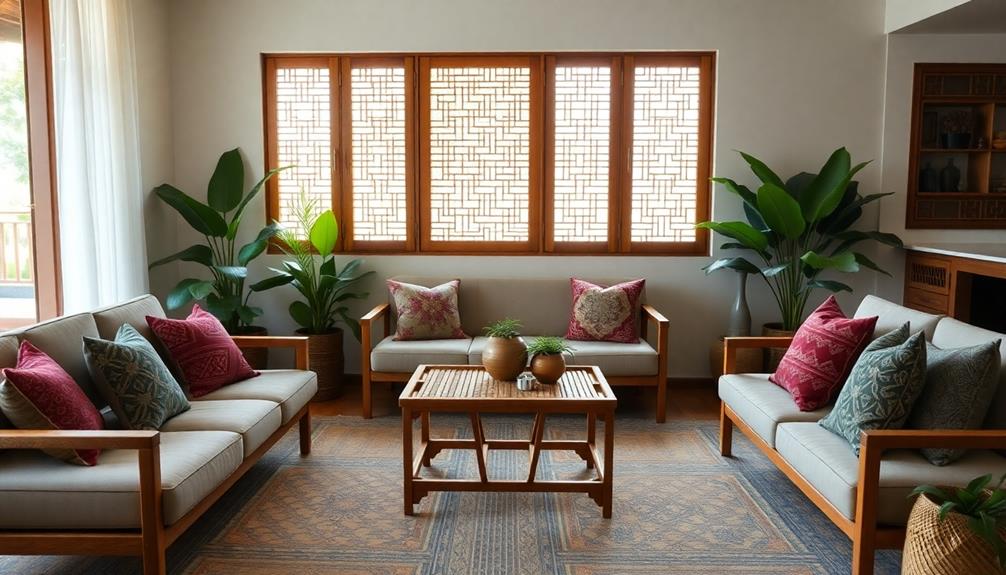
Indonesian home decor is rich with cultural influences that shape its unique aesthetic appeal. The blend of traditional and modern elements creates a vibrant atmosphere in urban settings. You'll find that furniture pieces often feature intricate wood carvings that echo local mythology, showcasing the craftsmanship inherent in Indonesian culture.
Here's a glimpse of some key cultural influences on aesthetics:
| Influence | Description | Design Ideas |
|---|---|---|
| Balinese Aesthetics | Intricate carvings and vivid wood panels | Use carved wooden cabinets |
| Batik Textiles | Ancient textile art adapted for modern decor | Motifs on cushion covers |
| Wayang Puppetry | Decorative art pieces celebrating heritage | Display puppets as wall art |
| Natural Materials | Sustainable options like rattan | Incorporate rattan furniture |
These cultural influences not only enhance the visual appeal of your space but also connect you to Indonesia's rich heritage. By integrating these elements, you can create a harmonious blend of tradition and contemporary design, making your home a true reflection of Indonesian aesthetics.
Furniture and Accessories Trends

How can you create a stylish yet functional space in an urban setting? Start by selecting furniture pieces crafted from natural materials like rattan and bamboo. These eco-friendly choices not only look good but also contribute to a sustainable lifestyle.
Incorporating elements like Indonesian decorative pillows can add vibrant colors and intricate patterns that enhance your living area. Embrace minimalist designs with low-profile furniture that promotes a relaxed atmosphere while optimizing your limited space.
Consider incorporating multi-functional furniture, such as convertible tables and storage ottomans, to maximize utility without sacrificing style. These versatile options are perfect for city living, allowing you to adapt your space as needed.
Don't forget to enhance your decor with handcrafted accessories like batik textiles and artisanal sculptures, which add cultural richness and unique character.
For outdoor furniture, look for stylish yet durable options that can withstand urban environments. Sliding glass doors can seamlessly connect your indoor and outdoor spaces, creating an airy feel while inviting natural light.
Integrating Nature and Open Spaces
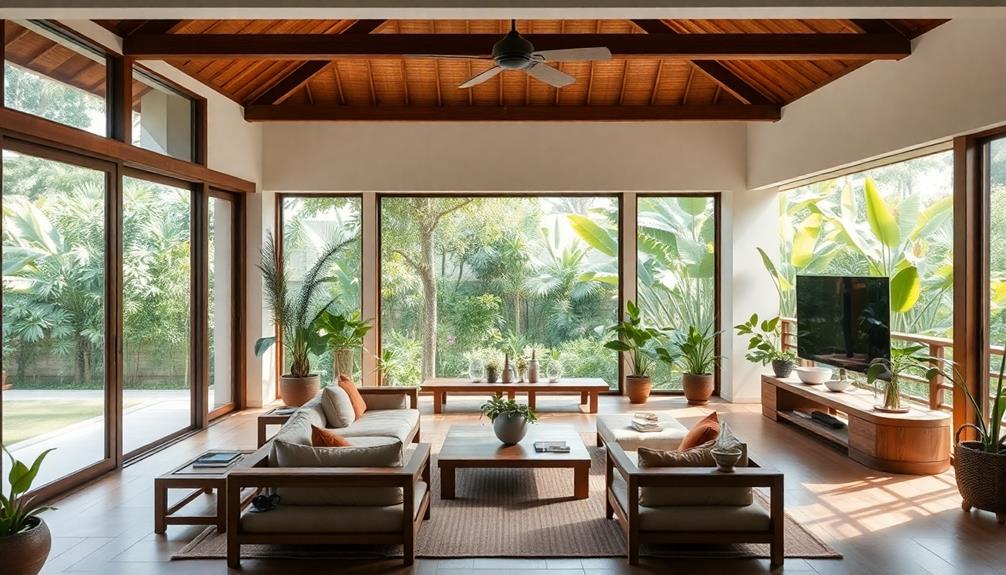
While creating a serene urban oasis, you can enhance your home's connection to nature by prioritizing open spaces that invite natural light.
Modern urban Indonesian decor focuses on seamless connections between indoor and outdoor areas, which makes your living space feel more expansive and connected to the lush environment outside.
Large windows and glass doors are essential in this design, as they frame outdoor views and let in abundant light, creating a bright, airy atmosphere.
To enrich the aesthetic, consider elements of traditional Indonesian style that incorporate intricate carvings and local textiles.
To further embrace this concept, consider incorporating landscaped gardens or private patios.
These features not only extend your living space but also invite greenery indoors, fostering a tropical ambiance.
Using natural materials like bamboo and stone adds to the tactile experience and enhances comfort in both your interiors and exteriors.
Water features like ponds or fountains can also be integrated, providing soothing sounds that reinforce the tranquil environment characteristic of modern Indonesian decor.
Balinese Design Characteristics

When you embrace Balinese design in your home, you'll notice a strong emphasis on natural materials like wood and stone, bringing warmth to your space.
The use of high-quality local materials enhances the authenticity of your decor, while incorporating elements from luxury tropical design aesthetics can elevate the overall ambiance.
You can also incorporate traditional motifs and intricate carvings that reflect Bali's rich cultural heritage, adding depth to your decor.
This combination creates an inviting atmosphere that celebrates both nature and artistry.
Natural Materials Emphasis
Modern urban Indonesian home decor often showcases a strong emphasis on natural materials, with wood, bamboo, and stone taking center stage. These elements create a warm and inviting atmosphere that reflects Balinese design characteristics. The use of handcrafted items, such as traditional artisanal masks, further enriches the space and emphasizes the appreciation for Indonesian cultural heritage.
By incorporating low-profile furniture made from these materials, you promote a relaxed ambiance that aligns perfectly with the Balinese aesthetic of comfort and tranquility.
In addition to the natural materials, you might notice vibrant colors and intricate patterns inspired by nature and local culture integrated into fabrics and decor. These enhancements add visual richness to your space.
Decorative elements, like carved wood artifacts and artisanal handicrafts, serve as focal points, connecting your home to Indonesia's rich cultural heritage.
Moreover, open floor plans and the seamless integration of indoor and outdoor spaces foster a sense of harmony with nature. This principle is essential in Balinese design and can be easily embraced in your modern urban home.
Cultural Motifs Integration
Integrating cultural motifs into your home decor not only enhances the aesthetic appeal but also tells a story that connects you to Indonesia's rich heritage. Balinese design characteristics are a perfect way to achieve this. By using natural materials like wood, bamboo, and stone, you create a warm and inviting environment that embodies the island's spirit.
Additionally, incorporating traditional artistry such as vibrant Indonesian decor masks can further enrich your space with cultural depth.
Incorporating intricate carvings and traditional motifs depicting Balinese mythology adds depth and storytelling to your space. These elements don't just serve a decorative purpose; they carry cultural significance that resonates with your lifestyle.
You can also elevate your decor with vibrant colors and patterns in textiles, drawing inspiration from local culture.
Balinese design often features open floor plans, promoting airflow and natural light, while seamlessly blending indoor and outdoor spaces. This creates a harmonious atmosphere, essential for urban living.
Sustainability in Home Decor
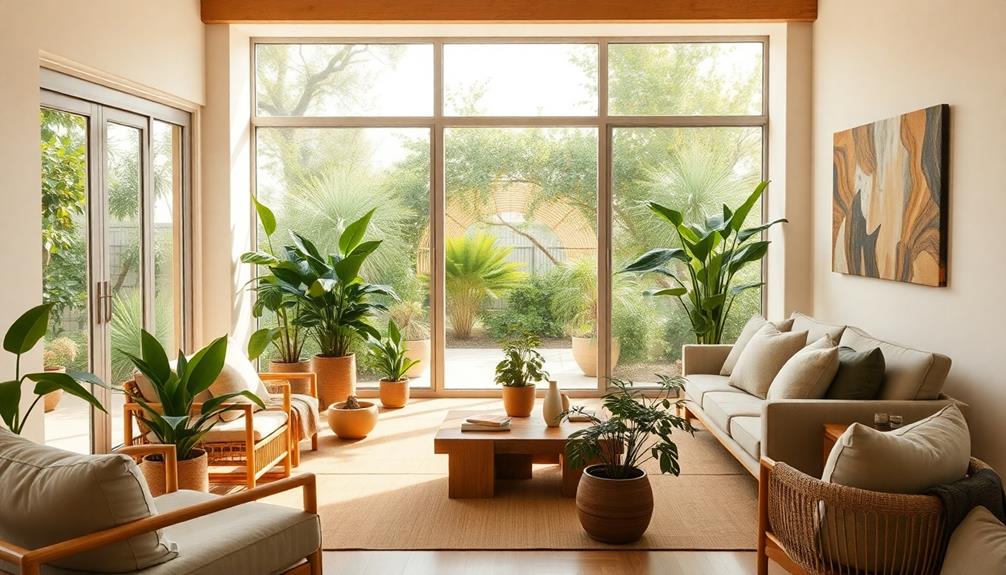
Emphasizing sustainability in home decor has become a hallmark of modern urban Indonesian design, where eco-friendly materials like bamboo and rattan take center stage. These materials aren't only sustainable but also locally sourced, which helps reduce the carbon footprint associated with imports.
Traditional Indonesian housing, known for its use of local materials, inspires many modern decor choices, creating a harmonious blend of the past and present traditional housing styles. You'll find that many Indonesian homes now incorporate renewable resources in construction, such as reclaimed wood and recycled materials, enhancing sustainable building practices.
Integrating indoor plants into your decor is another trend that enhances aesthetics while promoting air quality and well-being, aligning perfectly with sustainable living principles. Additionally, modern designs often showcase water conservation features, like rainwater harvesting systems, demonstrating a commitment to environmental sustainability.
Sustainable practices extend to textiles as well. You can choose fabrics dyed with natural dyes, like batik, which supports local artisans while minimizing environmental impact.
Practical Implementation in Urban Spaces
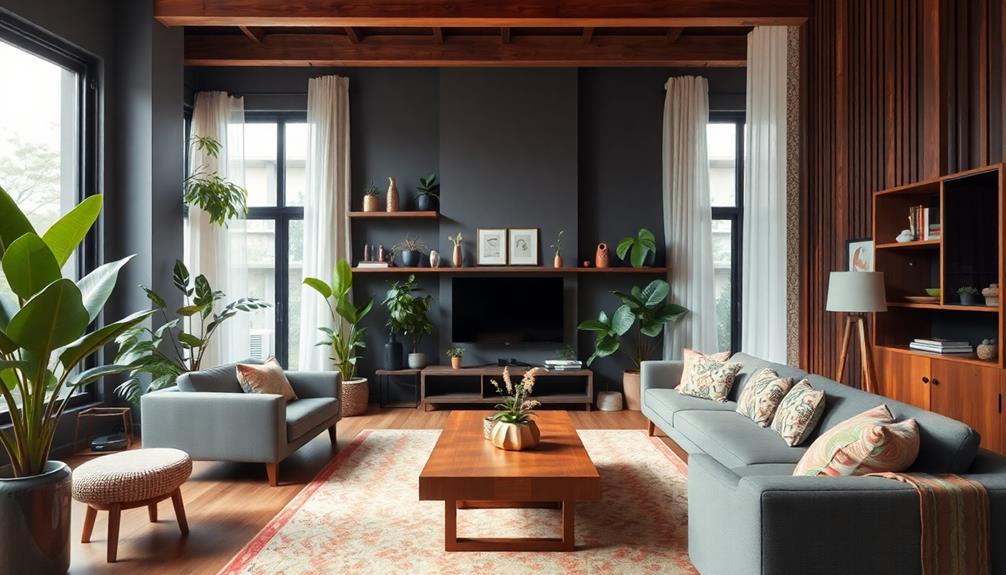
Maximizing space in urban Indonesian homes requires thoughtful design choices that blend functionality with style. One effective strategy is to incorporate multipurpose furniture, like foldable tables and storage ottomans, which help optimize your limited living area. These pieces allow you to adapt your space for various activities without cluttering it.
Additionally, consider adding vibrant colors inspired by Indonesian wedding decor ideas to create an inviting and dynamic atmosphere.
Adding organic elements, such as bamboo and rattan, creates warmth and texture, while also promoting sustainability. These materials not only enhance your decor but also connect your home to the natural environment.
Integrating indoor plants, like ferns and palms, brings a rejuvenating atmosphere to your space without taking up much room. They enhance the tropical feel that's characteristic of Indonesian homes.
To celebrate your culture, balance traditional artisan decor—think batik textiles or wood carvings—with minimalist designs. This creates striking focal points that reflect your heritage while maintaining a modern aesthetic.
Personalization and Individual Style

When personalizing your home, embracing unique cultural elements can truly set your space apart.
Incorporating items like Indonesian decor masks can add a rich cultural touch that enhances the aesthetic appeal of your environment.
You can blend traditional and modern styles, incorporating personal artifacts that reflect your journey and tastes.
This mix not only showcases your individuality but also creates a warm, inviting atmosphere that feels authentically yours.
Embracing Unique Cultural Elements
In modern urban Indonesian home decor, incorporating unique cultural elements allows you to create a space that truly reflects your identity. By integrating traditional elements like Batik textiles or Wayang puppets, you can express your cultural heritage in a fresh, contemporary way.
These items don't just serve as decor; they tell a story about who you're and where you come from. Emphasizing open spaces and natural light can also enhance the serene atmosphere of your home, reminiscent of tropical villa designs.
Handcrafted pieces, such as intricately carved wood furniture or artisanal rattan items, add character and warmth to your home. Each handcrafted piece is unique, making your space feel personal and inviting.
Additionally, using natural materials like bamboo and stone not only enhances the aesthetic appeal but also aligns with the growing trend of sustainability in urban design.
Don't shy away from bold colors and vibrant patterns inspired by local culture. They can invigorate your decor and create a lively atmosphere that celebrates your roots.
Incorporating Personal Artifacts
Building on the foundation of unique cultural elements, incorporating personal artifacts can further elevate your modern urban Indonesian home decor. These items, like family heirlooms or travel souvenirs, add unique character and rich storytelling to your space. They're not just decor; they represent your journey and experiences.
Handmade crafts, such as batik textiles or wayang puppets, showcase your cultural heritage while enhancing your personal aesthetic. Utilizing locally sourced materials, like rattan furniture or Balinese wood carvings, allows you to express your style while supporting sustainable practices. This connection to your environment adds an authentic touch to your decor.
Don't overlook personalized artwork or photography that resonates with your life experiences. These pieces enhance the ambiance and serve as conversation starters among guests. Blending contemporary design with traditional Indonesian motifs helps you create a unique fusion that expresses your identity while honoring your roots.
Incorporating personal artifacts is about more than just decoration; it's a way to tell your story. By thoughtfully selecting items that reflect who you are, you transform your home into a true reflection of your life and values.
Blending Traditional and Modern
Blending traditional and modern elements in your home decor creates a unique space that truly reflects your personality. You can incorporate traditional Indonesian textiles like batik and wood carvings alongside sleek, contemporary furniture to achieve a balanced aesthetic. This fusion not only respects your cultural roots but also showcases your individual style.
Using natural materials such as rattan and bamboo allows your decor to connect to Indonesian heritage while maintaining a chic, modern look. Handcrafted artisanal pieces add a layer of cultural significance and individuality, making your urban living space more personal.
Adapting traditional motifs—like intricate batik patterns and wayang puppetry—into modern designs brings a playful yet sophisticated touch to your home. The integration of open spaces and natural light enhances this personalization, creating a harmonious atmosphere that respects traditional design principles.
Here's a quick reference to guide your blending of styles:
| Traditional Elements | Modern Elements |
|---|---|
| Batik textiles | Minimalist furniture |
| Wood carvings | Sleek lines |
| Rattan and bamboo | Neutral color palettes |
| Handcrafted artisanal items | Open space concepts |
| Intricate patterns | Contemporary art |
Outdoor Spaces and Landscaping

Outdoor spaces in modern urban Indonesian homes are designed to be vibrant extensions of indoor living, seamlessly merging nature with contemporary aesthetics.
You'll often find lush gardens filled with tropical plants that not only enhance your home's beauty but also create a welcoming atmosphere. These outdoor areas are ideal for gathering with family and friends, reflecting the communal spirit of Indonesian culture.
Seating areas made from natural materials like wood and bamboo invite you to relax and enjoy the outdoors. You might also notice tranquil water features, such as ponds or fountains, which add soothing sounds and foster a deeper connection to nature.
Pathways crafted from natural stone or reclaimed wood lead you through these spaces, promoting sustainable landscaping practices while enhancing visual appeal.
To further extend your living area, consider incorporating Balinese-style pavilions or gazebos. These structures provide shade and shelter, making them perfect for entertaining or unwinding amidst the beauty of your garden.
Trends Post-COVID-19

The COVID-19 pandemic has undeniably transformed how we think about our living spaces, leading to a surge in multifunctional designs that cater to both work and leisure.
You might find yourself reimagining your home to accommodate remote work arrangements while still being a cozy gathering spot for family and friends.
Comfort is now a priority, so consider incorporating soft furnishings and natural materials like bamboo and rattan.
These elements not only add warmth but also enhance the aesthetic appeal of your space. Open floor plans are gaining traction, allowing for better airflow and light, making your home feel larger and more connected to nature.
With heightened awareness of hygiene, you'll want to integrate easy-to-clean surfaces and designated handwashing areas into your design.
This way, you can maintain cleanliness without sacrificing style.
Lastly, don't overlook the importance of outdoor spaces.
Terraces and gardens are becoming essential for safe socializing, offering a relaxing environment while keeping you connected to the outdoors.
Frequently Asked Questions
What Is Bali's Interior Design Style?
Bali's interior design style beautifully combines traditional aesthetics with modern minimalism. You'll find intricate wood carvings, vibrant textiles, and natural materials that create a warm atmosphere, along with open spaces that seamlessly connect indoors and outdoors.
What Is Modern Home Decor Style?
You might think modern home decor's all about chaos and clutter, but it's actually about sleek lines, minimalism, and natural materials. Embrace multipurpose furniture and smart features to create an inviting, functional space.
Conclusion
Incorporating modern urban Indonesian home decor means embracing vibrant colors, blending traditional elements, and celebrating open spaces. By integrating nature, personalizing your style, and creating inviting outdoor areas, you can transform your home into a sanctuary. As you navigate trends shaped by the pandemic, remember to balance practicality with aesthetic appeal, ensuring your space reflects both your identity and the rich cultural tapestry of Indonesia. Ultimately, your home should inspire, comfort, and connect you to your surroundings.
Home Decor
How to Implement Sustainable Rural Design in Indonesia
The path to implementing sustainable rural design in Indonesia begins with community engagement, but what innovative strategies can truly make a difference?

To implement sustainable rural design in Indonesia, start by engaging local communities and incorporating their traditional knowledge. Use eco-friendly agricultural practices, like agroforestry and organic farming, to enhance food security and biodiversity. Focus on sustainable water management through rainwater harvesting and community-based initiatives that improve water quality. Foster a multi-actor governance framework that promotes collaboration among stakeholders. This approach not only boosts local economies and job creation but also preserves cultural heritage and environmental health. If you explore further, you'll discover additional strategies and success stories for effective implementation.
Key Takeaways
- Engage local communities through participatory planning to ensure development meets their unique needs and incorporates traditional values.
- Integrate traditional agricultural practices, such as agroforestry and organic farming, to enhance sustainability and food security.
- Implement effective water management strategies, including rainwater harvesting and community-based watershed programs, to conserve water resources.
- Develop sustainable infrastructure that improves market access and connectivity for rural populations, supporting economic resilience.
- Monitor and evaluate initiatives using participatory approaches and measurable indicators aligned with Sustainable Development Goals (SDGs).
Importance of Sustainable Rural Design

Sustainable rural design is vital for preserving Indonesia's unique biodiversity and cultural heritage, as it seamlessly integrates ecological conservation with traditional values. By focusing on sustainable practices, you can foster economic development in rural communities, where agriculture employs around 38.23 million individuals and contributes considerably to the workforce.
This approach not only enhances local economies but also encourages responsible resource management, which is essential for mitigating environmental degradation. Incorporating traditional Indonesian housing styles, such as Rumah Adat, can further enrich sustainable design by promoting the use of local materials and cultural symbolism.
When you prioritize sustainable rural design, you help guarantee that rural communities can withstand the challenges posed by climate change. Improved resilience means that these communities can adapt to environmental shifts while maintaining their livelihoods.
Additionally, engaging local populations in decision-making fosters a sense of ownership and responsibility toward their environment, further strengthening community ties.
In Indonesia, with its rich tapestry of 74,961 villages, embracing sustainable rural design is more than an ecological necessity; it's a means to safeguard traditional values while promoting a sustainable future.
Engaging Local Communities

Community involvement is vital for successful rural design in Indonesia. Engaging local communities helps guarantee sustainable rural development that meets their unique needs. With around 74,961 villages depending on active participation, community-based development frameworks like Integrated Agriculture Development play an essential role in enhancing sustainability.
| Engagement Strategy | Benefits |
|---|---|
| Incorporating Local Culture | Fosters ownership among villagers |
| Strengthening Local Governance | Guarantees community voices are heard |
| Education and Awareness Programs | Empowers communities to contribute |
Using effective engagement strategies is key. Incorporate local culture and traditional practices into design processes to enhance the connection between projects and the community. Strengthening local governance structures facilitates participatory planning, making certain everyone has a say in decision-making.
Moreover, continuous education and awareness programs empower local communities, enabling them to actively contribute to sustainable rural design initiatives. By prioritizing these strategies, you can create a more inclusive environment that promotes community resilience and long-term sustainability. Engaging local communities will ultimately lead to more effective and meaningful rural development outcomes.
Integrating Traditional Knowledge
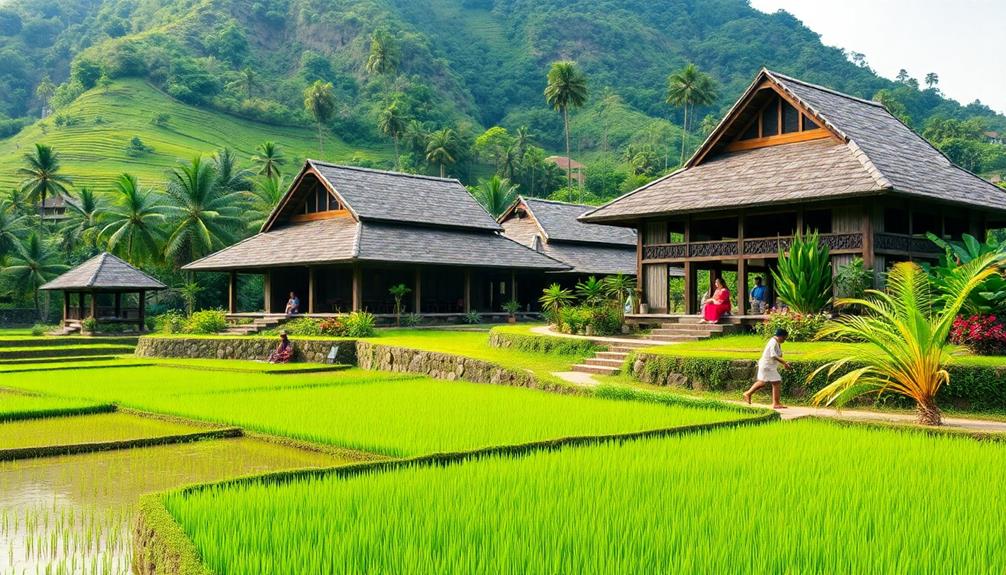
Integrating traditional knowledge into rural design can greatly enhance sustainability in Indonesia. By embracing local agricultural practices, you can help preserve ecosystems while boosting food security for rural communities, where about 70% depend on agriculture.
Traditional knowledge encompasses time-tested methods like agroforestry and rotational farming, which promote soil health and biodiversity. Additionally, implementing elements such as Indonesian decorative pillows can enrich living spaces with cultural heritage while supporting local artisans.
Incorporating these practices into your designs not only fosters sustainable development but also respects the rich cultural heritage of the community. Using local materials and traditional building techniques can markedly reduce the carbon footprint of new developments, creating structures that blend harmoniously with the environment.
Moreover, engaging local communities in the planning process empowers them to maintain and adapt their traditional practices, ensuring that designs reflect their unique needs and values. This community engagement is essential for creating solutions that are both practical and sustainable.
Eco-Friendly Agricultural Practices

Traditional knowledge lays a strong foundation for adopting eco-friendly agricultural practices in Indonesia. By embracing organic farming, you can utilize natural fertilizers and pest control methods, greatly reducing reliance on chemicals and promoting healthier soil.
Additionally, incorporating elements of traditional craftsmanship, such as the use of sustainable materials in farming tools, can further enhance your eco-friendly approach. Agroforestry systems are another great option; they integrate trees with crops, enhancing biodiversity and improving soil fertility, while potentially increasing your income through diverse product offerings.
In rural areas, rainwater harvesting techniques are becoming popular. These methods help conserve water resources, allowing you to collect rainwater for irrigation during dry seasons, ensuring your crops thrive.
Additionally, employing crop rotation and cover cropping can prevent soil erosion and depletion, maintaining nutrient levels and boosting overall agricultural productivity.
Cultural significance of masks can also inspire sustainable design practices that reflect local heritage.
The Indonesian government supports these sustainable practices by offering training programs and financial incentives for farmers who adopt eco-friendly methods. This initiative aims to increase the adoption rate of these practices nationwide.
Sustainable Water Management

Sustainable water management is fundamental for preserving Indonesia's rich water resources, which include over 5,000 rivers and countless lakes essential for local ecosystems and agriculture.
With about 70% of Indonesia's freshwater sourced from rainfall, effective rainwater harvesting and storage systems are crucial to address seasonal shortages. Traditional housing designs often incorporate features to manage water runoff effectively, showcasing a harmonious relationship between architecture and the environment traditional housing designs.
By implementing integrated water resource management (IWRM) practices, you can enhance water quality and availability, tackling pollution that threatens both human health and biodiversity.
Community-based initiatives, like local watershed management programs, empower rural populations to adopt sustainable practices and secure equitable access to water resources. These initiatives not only foster cooperation among community members but also strengthen rural economic resilience by promoting responsible water use.
Government policies, such as the National Water Resources Law (Law No. 17/2019), underscore the importance of sustainable water management to support agricultural productivity while protecting environmental and community interests.
Infrastructure Development Strategies

To effectively transform rural Indonesia, infrastructure development strategies must focus on creating sustainable roads and transportation networks that enhance access to markets and services. By prioritizing these sustainable roads, you'll improve connectivity for over 38 million individuals engaged in agriculture, enabling better access to essential services and markets.
Incorporating elements of luxury tropical design aesthetics can also inspire innovative community spaces that promote local culture and well-being. Integrating renewable energy solutions, like solar power, into your infrastructure projects can boost energy access while reducing reliance on fossil fuels. This step is significant for guaranteeing a sustainable future in rural areas.
Additionally, investing in water management systems and irrigation infrastructure is critical. It supports agricultural productivity and guarantees the efficient use of Indonesia's abundant water resources, which are significant for rural economies.
You should also consider establishing Village-Owned Enterprises (BUMDes) as they can drive local economic growth. These enterprises can create infrastructure that supports community-based development projects, enhancing self-sufficiency.
Moreover, emphasizing community participation during the planning and implementation phases guarantees that infrastructure projects align with local needs, making them more sustainable and culturally appropriate. By focusing on these strategies, you can lay the groundwork for a thriving, resilient rural Indonesia.
Multi-Actor Governance Framework

In Indonesia, multi-actor governance relies on collaborative decision-making processes that bring together diverse stakeholders.
This approach mirrors the intricate artistry found in traditional Indonesian decor masks, which often reflect the rich cultural narratives and community values.
You'll find that engaging local communities, NGOs, and the private sector not only fosters transparency but also enhances the effectiveness of rural development strategies.
Collaborative Decision-Making Processes
A robust multi-actor governance framework greatly enhances collaborative decision-making processes in sustainable rural design initiatives across Indonesia. By bringing together government agencies, local communities, NGOs, and the private sector, this approach guarantees that diverse perspectives are included.
Incorporating local cultural elements, such as Indonesian wedding decor ideas, into the planning process can enrich community engagement and foster a sense of ownership among participants. Participatory approaches play a significant role in integrating local knowledge and cultural values, making sustainable rural development more relevant and accepted.
When you foster effective multi-actor governance, you promote transparency and legitimacy in decision-making. This is especially important for marginalized communities, whose voices often go unheard. Establishing trust among stakeholders is essential; ongoing dialogue, shared goals, and mutual benefits can facilitate this trust-building process.
Moreover, successful collaborative decision-making leads to improved resilience and sustainability of rural projects. By facilitating resource sharing and coordinated action, you can optimize the use of available resources, guaranteeing that all stakeholders work towards common objectives effectively.
As you engage multiple actors, you not only enhance the quality of decisions but also empower local communities to take an active role in shaping their futures. Ultimately, this collaborative approach is key to achieving sustainable rural development in Indonesia.
Stakeholder Engagement Strategies
Engaging stakeholders effectively is essential in the multi-actor governance framework for sustainable rural design. By involving diverse community groups, local government, NGOs, and private sector actors, you enhance legitimacy and transparency. Implementing participatory planning processes empowers local communities to express their needs and preferences, ensuring that initiatives align with their cultural contexts.
Here's a simple table outlining effective strategies for stakeholder engagement:
| Strategy | Description |
|---|---|
| Participatory Planning | Engaging communities in the decision-making process. |
| Regular Meetings | Facilitating ongoing communication and updates. |
| Resource Sharing | Promoting collaboration for mutual benefits. |
| Trust Building | Utilizing informal networks to foster relationships. |
| Local Knowledge Integration | Leveraging community expertise for project relevance. |
Economic Benefits of Sustainability

Sustainable rural design in Indonesia creates increased local employment opportunities, directly impacting community economic resilience.
By adopting sustainable resource management practices, such as utilizing natural materials and promoting eco-friendly construction, you can help communities thrive while protecting their environment.
This approach not only boosts local economies but also guarantees a stable future for generations to come.
Increased Local Employment Opportunities
Creating local employment opportunities is an essential aspect of sustainable rural design in Indonesia. By focusing on eco-friendly agriculture, you can tap into an industry that employs around 38.23 million individuals, representing nearly 30% of the total workforce. This creates a strong foundation for economic growth and stability.
Incorporating elements of traditional Indonesian style home decor can also enhance local craftsmanship and provide job opportunities in art and design. Implementing community-based tourism initiatives will attract visitors, generating jobs and creating an economic multiplier effect that bolsters local businesses.
Investing in sustainable infrastructure, such as improved roads and irrigation systems, enhances access to markets, further increasing local employment opportunities. Additionally, renewable energy projects like solar farming not only provide jobs but also reduce reliance on non-renewable resources, promoting both economic and environmental sustainability.
Moreover, promoting Village-Owned Enterprises (BUMDes) empowers communities to create jobs locally. These enterprises are designed to enhance economic self-sufficiency, allowing for various sustainable ventures that benefit the entire community.
Enhanced Community Economic Resilience
Fostering local employment opportunities directly contributes to enhancing community economic resilience in rural Indonesia. By embracing sustainable practices, villages can markedly boost their local economies and provide better livelihoods for their residents.
This approach can also benefit from cultural elements, such as incorporating local traditions into community events, which can enhance Indonesian party decorations.
Here's how you can experience these benefits:
- Job Creation: Sustainable agriculture and eco-tourism generate new economic activities, employing local talent.
- Increased Income: Implementing sustainable practices can lead to a 10-20% rise in local income, which helps reduce poverty.
- Community-based Development: Focusing on local resources enhances food security and self-sufficiency, reducing reliance on external markets.
- Tourism Revenue: Prioritizing sustainability can attract more visitors, increasing tourism revenue by 15-30%, which can be reinvested into local initiatives.
Sustainable Resource Management Practices
When you think about the economic benefits of sustainability in rural Indonesia, sustainable resource management practices stand out as a powerful tool for enhancing livelihoods. By adopting methods like agroforestry and organic farming, farmers can boost their income by up to 30% compared to conventional practices. This increase plays a crucial role in fostering economic growth in rural areas.
Additionally, community-based fisheries management (CBFM) has shown remarkable results, improving fish stocks by 20-50%. This not only sustains fish populations but also secures better livelihoods for local fishing communities.
Eco-friendly tourism initiatives can further enhance the economy, generating up to 15% more revenue while preserving local culture and the environment.
Utilizing renewable energy sources, such as solar and biogas, offers another way to manage resources sustainably. These solutions can reduce energy costs by around 40%, providing significant economic savings for local communities.
Furthermore, engaging these communities in sustainable land management practices has been linked to a 25% reduction in soil erosion, which helps maintain agricultural productivity and strengthens ecosystem resilience.
Embracing these practices is essential for a prosperous and sustainable future in rural Indonesia.
Monitoring and Evaluation Techniques
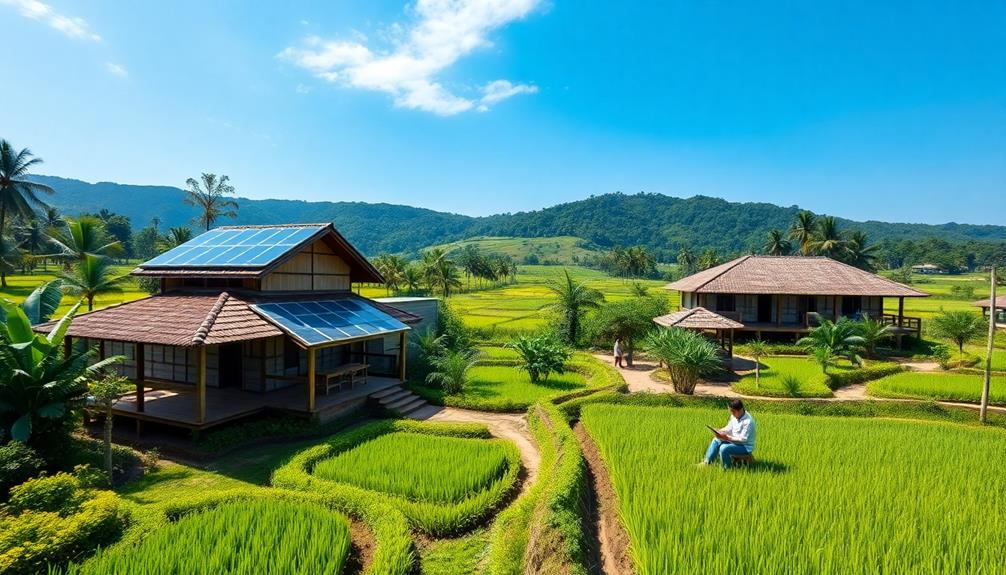
Effective monitoring and evaluation (M&E) techniques play an essential role in ensuring the success of sustainable rural design in Indonesia.
To effectively assess the progress of your initiatives, you should focus on several key strategies:
- Set clear measurable indicators aligned with the Sustainable Development Goals (SDGs).
- Utilize participatory approaches to involve local communities in the evaluation process.
- Collect regular community feedback through surveys and other mechanisms.
- Leverage Geographic Information Systems (GIS) for spatial data analysis.
Case Studies in Indonesia
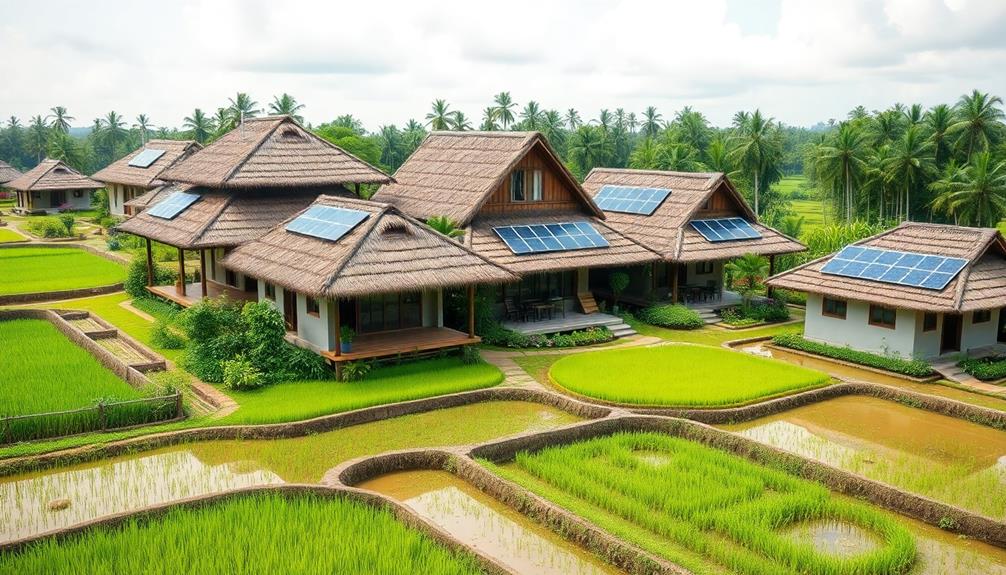
Numerous case studies in Indonesia showcase the impactful results of sustainable rural design through community-driven initiatives. For instance, the Integrated Agriculture Development (IAD) program enhances local food production while preserving biodiversity, demonstrating how community-based initiatives can address food security.
The Community-Based Forest Management (CBFM) initiative has empowered local communities to manage forest resources sustainably, leading to a remarkable 20% increase in forest cover over five years.
In coastal areas, the Ecosystem Approach to Fisheries Management (EAFM) has considerably improved fish stocks and local livelihoods, with a 30% rise in fishery yields since its implementation.
These examples highlight how rural development projects, supported by the Village Fund Program, foster local infrastructure and community empowerment. Established by Law No. 6 of 2014, this program has provided over IDR 70 trillion (approximately USD 5 billion) to support these initiatives.
Moreover, successful case studies underline the importance of participatory planning. When local stakeholders actively engage in decision-making, more than 80% report increased satisfaction with rural development outcomes.
This engagement is critical for achieving lasting impacts in sustainable rural design in Indonesia.
Frequently Asked Questions
What Sustainability Strategies Have Been Implemented in Indonesia?
Indonesia's implemented sustainability strategies include the Village Fund Program for community projects, Integrated Agriculture Development for eco-friendly farming, Community-Based Forest Management for resource stewardship, and Ecosystem Approach to Fisheries Management for protecting marine biodiversity and supporting livelihoods.
How Can We Make Sustainable Rural Communities?
"You reap what you sow." To create sustainable rural communities, engage locals in decision-making, blend traditional knowledge with modern practices, support entrepreneurship, and provide ongoing training. This guarantees resilience and long-term benefits for everyone involved.
How Can Sustainable Development Be Improved in Rural Areas?
You can improve sustainable development in rural areas by engaging communities actively, adopting community-based frameworks, strengthening governance, securing financial strategies, and continuously evaluating practices to fit unique cultural and environmental contexts.
Conclusion
In embracing sustainable rural design in Indonesia, you're planting seeds of hope for vibrant communities and flourishing ecosystems. By weaving together local voices, traditional wisdom, and green practices, you're not just building structures; you're nurturing a tapestry of resilience. As you cultivate these initiatives, you'll see the fruits of your labor—economic growth, strengthened ties, and a thriving environment. Let this journey be a gentle breeze that carries you and the communities towards a sustainable and prosperous future.
Home Decor
Embracing Sustainable Rural Design in Indonesia
Discover how Indonesia’s sustainable rural design intertwines culture and ecology, paving the way for vibrant communities—what innovative practices are emerging next?
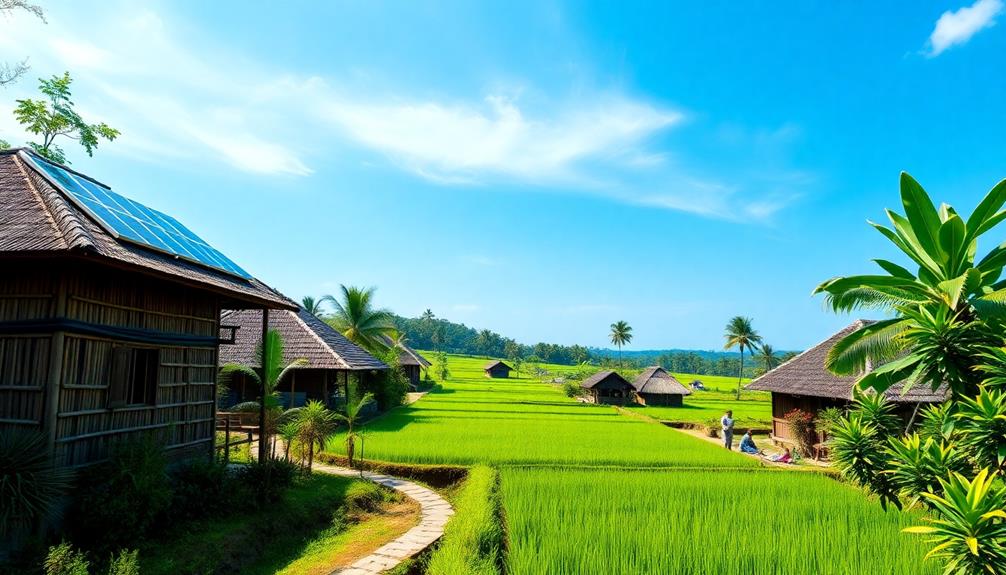
Embracing sustainable rural design in Indonesia involves blending local culture with ecological practices for vibrant communities. You'll see initiatives that prioritize community involvement and leverage Traditional Ecological Knowledge for sustainable agriculture. Local materials reflect rich traditions, while participatory design methods build resilience and social unity. Economic benefits flourish through responsible forestry and crop diversification, increasing household income and improving market access. By managing protected forests, locals enhance biodiversity and conserve essential resources. This approach not only supports environmental health but also aims for future tourism and rural empowerment. There's much more to explore about these inspiring practices and their impacts.
Key Takeaways
- Sustainable rural design in Indonesia integrates local materials and traditional housing styles to reflect cultural identity and ecological preservation.
- Community engagement is essential, allowing residents to participate in decision-making processes that shape their environment and foster social cohesion.
- Utilizing Traditional Ecological Knowledge (TEK) enhances sustainable agricultural practices, promoting biodiversity and resilience in rural communities.
- Community-based forestry management empowers households, increases income through diverse crops, and improves local water supply while conserving forest resources.
- Future goals focus on eco-tourism development and collaboration with government bodies to establish replicable models for sustainable resource management.
Overview of Sustainable Rural Design

Sustainable rural design in Indonesia plays an essential role in balancing ecological preservation with local cultural identities. This approach emphasizes community engagement, ensuring that residents actively participate in shaping their environment.
By integrating Traditional Ecological Knowledge (TEK), practices like Niteni highlight the importance of observing natural phenomena to promote sustainable agriculture, fostering both ecological balance and regional identity. Additionally, the integration of local materials in construction can reflect traditional Indonesian housing, further enriching the cultural significance of sustainable design.
Participatory design methods encourage you to become co-designers in your community, creating innovative solutions that enhance resilience and social cohesion. These methods help develop sustainable rural designs that not only protect biodiversity but also strengthen local economies.
Job creation in sectors like hospitality and agriculture results from these efforts, contributing to the local GDP while ensuring equitable access to land rights and resources.
Successful examples, such as Taba Padang village, demonstrate the effectiveness of sustainable rural design in improving livelihoods through community-based forestry management. By harnessing eco-tourism opportunities, these initiatives help protect biodiversity while simultaneously enhancing the quality of life for residents.
Ultimately, embracing sustainable rural design means investing in a future where ecological preservation and cultural heritage thrive together.
Community-Based Forestry Management

In the heart of Taba Padang village, community-based forestry management has transformed the way residents interact with their environment. This initiative allows 470 households to manage 1.5 hectares of protected forest each, promoting sustainable agriculture and biodiversity conservation.
With an emphasis on integrating traditional practices, local artisans also contribute by creating Indonesian decorative pillows that reflect cultural heritage, adding a touch of vibrancy to the community's living spaces. Spearheaded by village chief Yoyon, it took nearly four years to secure permits, prohibiting land clearing for plantations while allowing crops to thrive in the understory.
Since implementing this model, farmers have reported significant income increases through the cultivation of coffee, pepper, durian, and rattan. Additionally, they've enjoyed improved water supply from forest farms, which is essential for rural development.
Regular inspections by officials every five years guarantee adherence to conservation practices, reflecting the community's commitment to forest protection and sustainable land use.
Taba Padang's success has garnered recognition from the Indonesian Ministry of Environment and Forestry, showcasing a balanced approach to economic growth and environmental conservation.
Economic and Social Benefits
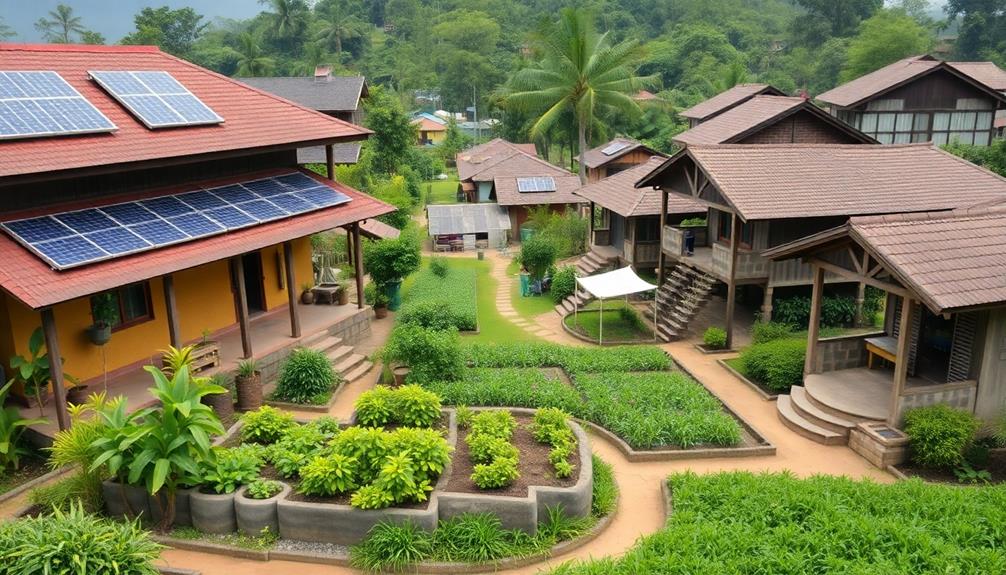
The implementation of community-based forestry management in Taba Padang village has brought tangible economic and social benefits to its residents. By focusing on sustainable farming practices, 470 households have experienced significant income increases through the cultivation of coffee, pepper, durian, and rattan. This economic upliftment has been further enhanced by improved transportation, as motorbikes now enable farmers to efficiently transport their harvests to markets.
Furthermore, the use of local materials in housing can potentially complement these agricultural practices, creating a holistic approach to rural development.
Additionally, the effective management of forest resources has led to an improved water supply, which has positively impacted agricultural productivity and the overall quality of life within the community. The recognition from the Indonesian Ministry of Environment and Forestry not only validates these local efforts but also opens doors for eco-tourism, presenting new opportunities for rural development.
As community members engage in sustainable practices, they feel more empowered, reducing anxiety over legal repercussions related to farming in protected areas. This shift fosters a sense of local governance, allowing residents to take charge of their resources and future.
Essentially, the economic and social benefits of community-based forestry in Taba Padang create a more resilient and thriving community.
Environmental Conservation Strategies

Shifting from deforestation to a focus on reforestation and conservation has transformed Taba Padang village into a model of environmental stewardship. By recognizing forest conservation as crucial for community livelihoods, you can see how sustainable practices thrive here. With each household managing 1.5 hectares in a protected forest, land clearing for plantations is prohibited, allowing for the cultivation of diversified crops in the understory, which helps maintain ecological balance.
Here's a snapshot of the environmental conservation strategies being employed:
| Strategy | Description |
|---|---|
| Protected Forest | 9.95 square kilometers managed by local farmers |
| Crop Diversification | Coffee, pepper, durian, and rattan cultivated |
| Regular Inspections | Conducted every five years for compliance |
| Biodiversity Promotion | Conservation of rare species like Hornstedtia rubra |
| Community Engagement | Fostering involvement in wildlife protection |
These initiatives not only enhance biodiversity but also play a significant role in rural development. The village's commitment to environmental conservation shows that preserving nature can lead to thriving community livelihoods and a sustainable future.
Future Aspirations and Goals
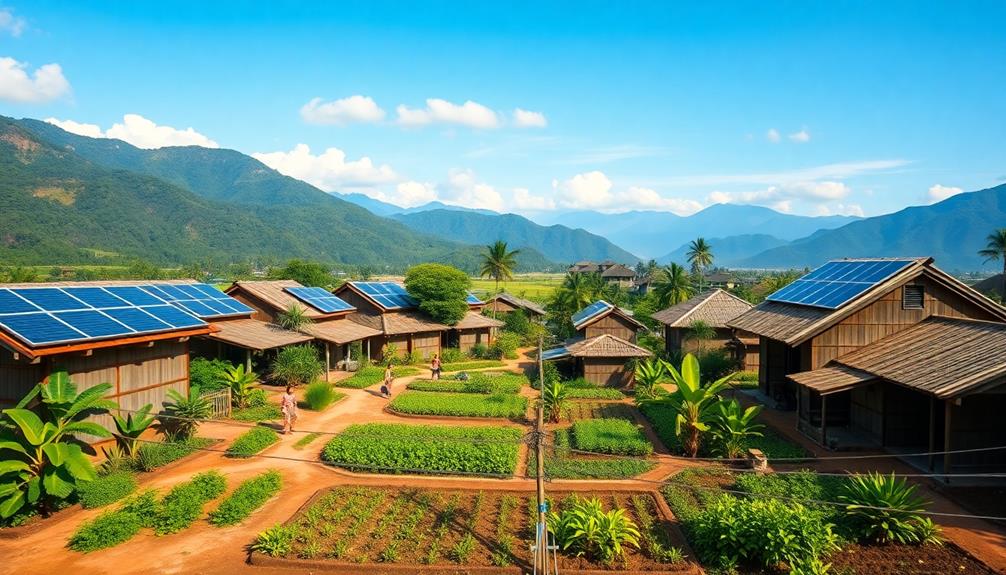
As Taba Padang village looks to the future, it's determined to enhance local welfare while preserving its precious forest resources. The community's commitment to sustainable development is evident as they actively engage in conservation efforts, ensuring the sustainable management of their forested areas.
By prioritizing forest conservation, you're not just protecting the environment; you're improving the quality of life for everyone in the village. This commitment aligns with principles found in tropical architecture, which emphasizes harmony with the natural surroundings.
Local tourism is a key focus, with aspirations to attract visitors to natural attractions like waterfalls and hot springs. This approach can boost the village's economy and create job opportunities, benefiting local communities.
You'll see that the integration of community-based forestry management is essential, as it empowers residents to take charge of their natural resources. Collaborating with government bodies will also play a significant role in refining these sustainable practices.
Taba Padang aims to serve as a replicable model for other Indonesian villages, demonstrating effective natural resource management and sustainable development. By embracing these goals, you're not just enhancing local welfare today; you're ensuring a sustainable and prosperous future for generations to come.
Frequently Asked Questions
What Sustainability Strategies Have Been Implemented in Indonesia?
In Indonesia, you'll find strategies like community-managed forests, diverse crop cultivation, and regular inspections promoting sustainable practices. By integrating Traditional Ecological Knowledge, locals engage in participatory designs, enhancing resilience and sustainable development in their communities.
What Is the Indonesia Sustainable Landscapes Management Program?
The Indonesia Sustainable Landscapes Management Program focuses on improving livelihoods through sustainable forest management. You'll engage with communities, governments, and the private sector to address deforestation, enhance food security, and guarantee equitable land access.
How Can We Make Sustainable Rural Communities?
You know the saying, "Many hands make light work." To create sustainable rural communities, engage locals in decision-making, utilize traditional knowledge, diversify economies, and foster collaboration, ensuring everyone's voice contributes to a thriving, resilient future.
Why Is Sustainability Important in the Rural Areas?
Sustainability's essential in rural areas because it preserves biodiversity, enhances local livelihoods, and strengthens community ties. By adopting sustainable practices, you're not only protecting the environment but also fostering economic resilience and social cohesion for future generations.
Conclusion
In embracing sustainable rural design, you're not just enhancing the environment; you're fostering vibrant communities. Did you know that Indonesia's community-based forestry management has led to a 30% increase in local incomes? By prioritizing eco-friendly practices, you're contributing to a healthier planet and empowering local economies. As you look to the future, keep pushing for innovative strategies that balance economic growth with environmental stewardship. Together, you can make a lasting difference for generations to come.
-

 Vetted5 months ago
Vetted5 months ago14 Best Personalized Father's Day Gifts for Your Husband – Show Him You Care
-

 Alfresco4 months ago
Alfresco4 months agoAlfresco Stacker Doors: Seamless Indoor-Outdoor Living!
-

 Vetted5 months ago
Vetted5 months ago15 Best EMS Foot Massagers for Neuropathy to Soothe Your Feet
-

 Craft and Textiles6 months ago
Craft and Textiles6 months ago15 Best Places to Buy Appliances for Your Home – Top Retailers Reviewed
-

 Craft and Textiles6 months ago
Craft and Textiles6 months ago15 Best Battery-Powered Leaf Blowers for Effortless Yard Work
-

 Craft and Textiles6 months ago
Craft and Textiles6 months ago15 Best Cordless Mowers for Effortless Lawn Care – Top Picks of 2024
-

 Craft and Textiles6 months ago
Craft and Textiles6 months ago15 Best Gifts for 4-Year-Old Girls That Will Spark Joy and Creativity
-

 Tableware and Dining Accessories6 months ago
Tableware and Dining Accessories6 months agoWhat Is the Hindi Meaning of Tableware










